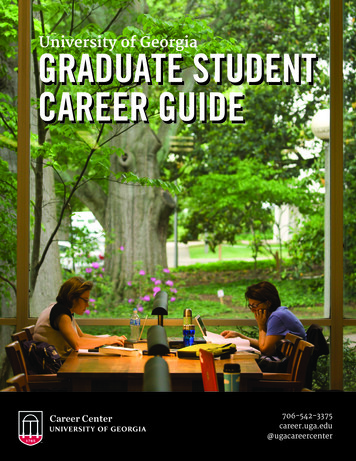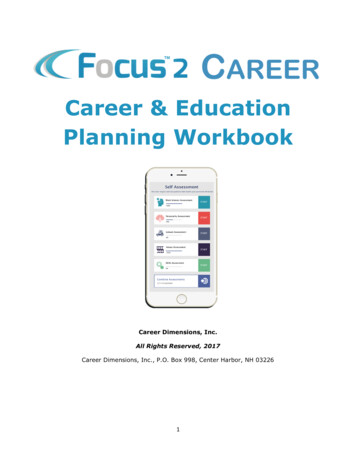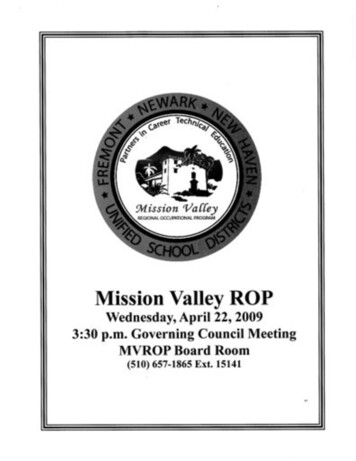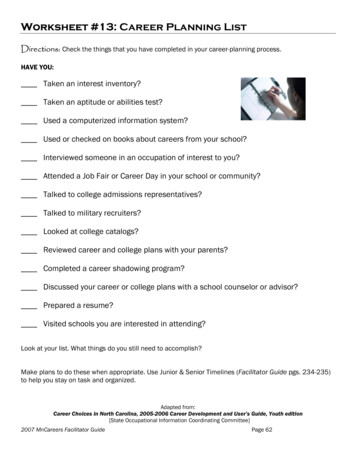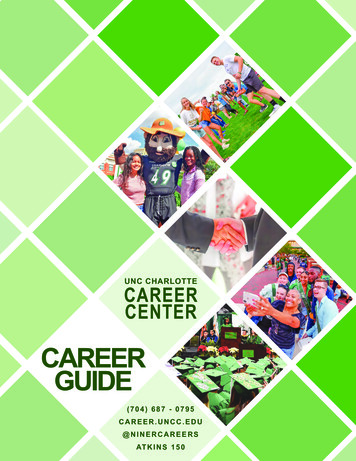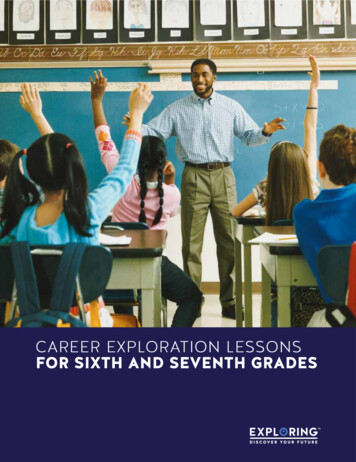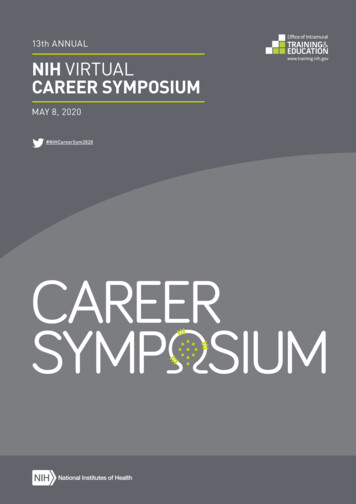
Transcription
SAFETY GUIDEFORCAREER AND TECHNICAL EDUCATIONDr. Terry BergesonState Superintendent of Public InstructionMary Alice HeuschelDeputy SuperintendentLearning and TeachingMickey LahmannAssistant SuperintendentCurriculum and InstructionRob FieldmanDirectorCareer and Technical EducationMoe BroomProgram SupervisorTechnology and Industry PathwayCompiled and Edited by:Mike OppFormer Program SupervisorTechnology and Industry PathwayTechnical Assistance by:Robbie Stanford and Jennifer OlsenCareer and Technical EducationThis material is available in alternative format upon request. Contact Career and Technical Education,360-725-6241, TTY 360-664-3631. The Office of Superintendent of Public Instruction complies with allfederal and state rules and regulations and does not discriminate on the basis of race, color, nationalorigin, sex, disability, age, or marital status.May 2002 (Updated September 2002)Section 1 Page 1
TABLE OF CONTENTSGuide Intent .5Introduction .6Purpose .7Definition.8Section I—Instructor InformationLegal Duties of Instructor.11-14Managing Risk . 15Career and Technology Education Program Standards.16-17Safety and the Law .18-22Safety Forms .23-33Career and Technical Education Facilities Checklist . 34WAC Codes .35-38WISHA Standards. 39Free Services 40Section II—General Safety Practices . 41Hazardous Waste . 42Eye Safety .43-46Ergonomics.47-48MSDS.49-52Electrical Protection .53-57Portable Ladder Safety .58-63Fire Safety .64-69First Aid.70-73General Safety Practices .74-85Automotive Technology .86-92Auto Body Collision Repair .93-99Commercial Foods.100-101Drafting .102-103Construction Trades .104-117Graphic Arts.118-119Metal Trades–Machine ness and Office Occupations.126-127Health Occupations .128-131Family and Consumer Sciences.132-135Marketing .136-137Trade and Industrial Education.138-145Computer Use/Online Rules.146-148Section III—Machine Specific Safety Rules and TestsTRANSPORTATION TRADES. 149Air Chisel .150-151Air Sanding Tools .152-153Drill Press .154-157Gas Forge.158-161Grinder .162-164Impact Wrench.165-167Section 1 Page 2
TABLE OF CONTENTS (continued)Section III—Machine Specific Safety Rules and TestsParts Washer.168-169Portable Drill.170-173Portable Grinder.174-176Sand Blaster.177-178Service Jack .179-180Soldering Station.181-184Storage Batteries .185-186TIG and MIG Welder .187-189Tire Changer .190-191MANUFACTURING/WELDING/METALS TRADES. 192Arc Welder.193-196Buffer.197-199Crucible Furnace.200-203Grinder .204-206Drill Press .207-210Horizontal Milling Machine .211-214Metal Lathe.215-217Oxyacetylene Welder .218-220Portable Belt Sander .221-223Portable Drill.224-226Portable Grinder.227-229Sheet Metal Machines.230-231Soldering Station.232-234Spinning Lathe .235-237Tig and Mig Welder .238-240Spot Welder.241-242Manual and Power Shears.243-245CONSTRUCTION/WOOD TRADES . 246Band Saw .247-251Belt Finishing Sander .252-254Circular Saw Portable .255-257Disc Sander.258-261Jig/Bayonet Saw .262-264Jointer.265-268Motorized Miter Box .269-273Planer/Surfacer .272-280Portable Belt Sander .281-283Portable Drill.284-286Portable Finishing Sander.287-289Portable Router .290-293Radial Arm Saw .294-298Scroll Saw .299-303Table Saw .304-306Wood Lathe .307-311Uniplane .312-313Portable Electric Plane.314-315Wood Shaper .316-317GRAPHIC ARTS/COMMUNICATION TRADES . 318Hot Glue Gun . 319Cutter. 320Platemaker .321-322Drill . 323Press .324-326Section 1 Page 3
TABLE OF CONTENTS (continued)Screen Printing.327-328Tools. 329Photography .330-333Studio Lighting .334-337Photo Finishing Equipment .338-341Print Dryer . 342Dry Mount Press .343-344CULINARY ARTS . 345Blender .346-347Broiler .348-349Buffalo Chopper .350-351Convection Oven.352-353Conventional Oven.354-355Deep Fat Fryer .356-357Food Processor.358-359Gas Cheese Melter .360-361Gas Range .362-363Griddle.364-365Large Food Mixer .366-367Meat Grinder .368-369Power Meat Saw .370-371Slicer .372-373Steamers . 374Steam Kettle.375-376Steam Table .377-378Tilting Brazier .379-380Toaster .381-382Vertical Power Shredder .383-384TECHNOLOGY EDUCATION. 385Hot Glue Gun . 386Robotics .387-390Soldering Station.391-394Section IV—General Safety/ Unit of Instruction with tests . 395Equipment Safety Notes . 396GENERAL SAFETY UNIT TEXT EXAMPLESGeneral Safety—Part I .397-399General Safety—Part II .400-402Sample Safety Unit of Instruction.403-411Hand Tool.412-414Portable Power Tool.415-417Power Equipment.418-420Sheet Metal Machine .421-422Milling Machine.423-424Metal Squaring Shear .425-426Section V—NIOSH Checklists for Programs . 427Section VI . 428Color Coded Signs .429-456Resources .457-461Section 1 Page 4
GUIDE INTENTThis guide is intended to be a reference document that complements other printedmaterials on this subject that are produced and made available at the state andnational level.Industrial committees, whose members are actively engaged in these occupationsand who represent a major part of trade and industrial education in the state ofWashington, have validated this safety guide. Career and technical educationprogram course objectives should prepare students to meet these safety standards.Workers meeting these standards, as established by industry, will have the bestsafety record in the world of work.This document is solely for informational purposes. It does not purport to beexhaustive of its subject matter. The authors of this material make no warranty as tothe accuracy or completeness of the information contained in this document. Theauthors further assume no liability or responsibility for loss or damage suffered due toreliance on this material.Section 1 Page 5
INTRODUCTIONThe safety mistakes a student/technician/instructor makes today could have futureramifications both personally and environmentally. This guide is designed to helpinstructors/teachers instill safety awareness in their students. It is also intended toalert the school district staff to their areas of responsibility and, at the same time, toreduce accidents and exposure to litigation.Effective safety awareness education leads to safer attitudes and safetyconsciousness, which, in turn, lead to safer working practices and accident preventionwithin the CTE laboratory.The task of overcoming the “it can’t happen to me” attitude is a big one and requiresthat safety awareness be an integral part of the every day instruction program.In addition to the traditional safety point of view in both personal and area safety, newemphasis should be considered in COMPONENT safety, in that new, sophisticated,and computerized equipment must be well cared for because of high replacementcosts. One will find that safe operators that save people will also save equipment.A more recently recognized safety problem concerns hazardous waste and hazardouswaste disposal. An unsafe act today could have serious effects years from now.Safety consciousness requires that the student be educated in safety generally andspecifically. The teacher, in working to develop a positive attitude toward safety,should teach the student to ask “Is what I am about to do unsafe in any way to myself,to others, or to property?” It is essential that the instructional methods lendthemselves to positive safety attitude development. This includes (1) a clean andorderly working environment, (2) the awareness of possible accident situations whererespect replaces fear, (3) the importance of rules and regulations, (4) the necessity toteach the correct way to perform the first time, (5) the knowledge and skills in the useand the proper maintenance of tools and machines, (6) the reinforcement of safeoperating procedures, and (7) proper respect for hazardous wastes and hazardouswaste disposal.The Safety Guide for Career and Technical Education (CTE) is developed byparticipation from industry representatives who represent Washington IndustrialSafety and Health Act (Labor and Industries/ WISHA), Department of Health (DOH),Office of Superintendent of Public Instruction (OSPI), and CTE advisory committee.We encourage all users of the guide to recognize that the practices specified orrecommended include some that are already required by code or law and others thatare recommendations, which may help promote safety practices in Washington State.Please report any information that may be used to update and improve the safetyguide to OSPI.Section 1 Page 6
Student participation greatly increases the effectiveness of any safety educationprogram. Students should be actively involved in planning and presenting programsand demonstrations that involve the subject of safety as well as the care andmaintenance of tools and machines.Section 1 Page 7
PURPOSEPURPOSETo reduce and eliminate accidents in educational shops, labs, and the workplace by:Having instructors aware of dangers and risks to themselves, the students, andvisitors.Providing the instructors with knowledge to be able to make the lab, shop,classroom, or workplace a safe environment and meet Labor and Industries/WISHA and DOH standards.Providing recommendations to improve the safe environment for learning orworking.Providing examples of important records and forms for evidence of compliance.Providing a basic understanding of the educator’s legal responsibilities.Providing rules and regulations of Labor and Industries / WISHA and DOH.Provide a framework for teachers to include safety awareness or safety trainingin their curriculum and daily instructional practices.Section 1 Page 8
DEFINITIONSAFETY ISFREEDOM FROMDANGER, RISKS, OR ACCIDENTSTHAT MAY RESULT ININJURY, DEATH, OR PROPERTY DAMAGE.“Every year over 6,000 Americans die from workplace injuries. An estimated 50,000people die from illnesses caused by workplace chemical exposures and 6,000,000people suffer non-fatal workplace injuries. Injuries, alone cost the economy more than 110,000,000 a year.”The New OSHA Reinventing Workers Safety and HealthSection 1 Page 9
SECTION ISection 1 Page 10
Legal Duties of InstructorDUTY TO INSTRUCT—foreseeable“An instructor who does NOT instruct properly could place a student in adangerous situation where the lack of appropriate information mightcontribute to an accident.”“A prudent instructor must ANTICIPATE and EXPLAIN/DEMONSTRATEany problems that could arise for each experience and instruct proper safetyto the students.”DUTY OF SUPERVISIONInstructors are responsible for APPROPRIATE BEHAVIOR on thestudent’s part.If one student hurts another, it is the instructor who is the responsibleadult.Instructors must teach and maintain CLASSROOM CONTROL.The instructor is IN LOCO PARENTIS—You are the local parent and theresponsible adult during the educational experience.DUTY TO MAINTAINInstructors are responsible for seeing that EQUIPMENT is kept in safeworking order.To further delineate the role of the instructor in safety and the expectations of society,the following issues are addressed:Underlying reason and prudence.Facility, tool, and equipment concerns.Personal and student training, education, and preparedness.Present judiciary support, direction, and definition.Section 1 Page 11
Underlying Reason and PrudenceLabor and Industries / WISHA dictates what an instructor can do to protect students,self, and others while providing a learning experience for eager, young minds. DOHdictates student safety. The court system understands that an instructor(s) who is doingeverything reasonable and prudent and within the law (i.e., Labor and Industries /WISHA) under the given circumstances to supervise students working in a shopenvironment is doing what he or she should do to maintain a safe learning environment.As you, the instructor ponder your concerns involving facility, hand tools, power tools,and equipment that may pose a risk to students, you must take reasonable andprudent steps to prevent accidents from happening.Facility, Tool, and Equipment ConcernsAs we know, nothing is 100 percent safe. A person can be injured as simply as selfimpalement by a pencil or tripping down a set of stairs, if not used correctly. Do we notuse pencils and stairs, then? Society has provided you a “nod of its head” by realizingthat you teach a discipline that is outstanding compared to any other at this level ofeducation. Society WANTS you to give students this experience that no other schooldiscipline can offer. Society trusts you to do it, do it well, and do it safely as long as youcomply with society’s laws as an employee (Labor and Industries / WISHA).As a professional, it is reasonable and prudent that you maintain relatively clean,uncluttered facilities. Properly working tools and equipment, safety signs, posters, andfloor markings where applicable, safety guards, the wearing of Personal ProtectiveEquipment (PPE), etc., are examples of reasonable and prudent measures andexamples of Labor and Industries / WISHA requirements to protect all persons in theshop environment. Should there be a facility, tool or equipment concern that you as theprofessional feel does not allow safe education to take place in a reasonable andprudent manner, immediately contact your supervisor to resolve how to bring the articlein question back into reasonable and prudent compliance. Also, be fair in developingyour paradigm of what reason and prudence entails. Look at the scenario from society’spoint of view. The phrase “not everything goes” is critical in the CTE educationalenvironment. That’s part of what makes you a professional. All instructors are obligatedto follow all LAB Labor and Industries / WISHA regulations at all times.Section 1 Page 12
Often middle and junior high schools get the “hand-me-downs” from high schoolprograms because they do not receive CTE enhancement dollars to assist in properlymaintaining their facilities and equipment. Please conceptualize what a reasonable andprudent person would think a student at the middle/junior high school age should beexperiencing in this environment and what operations they should be performing. In thefollowing section, Managing Risk, there are recommendations for the junior high/middleschool age appropriators for power equipment usage.Personal and Student Training, Education, and PreparednessIt is crucial that you, as a professional, obtain and keep current your credentialsand training so that you, in turn, may provide your students with a quality, safelearning experience. It is your responsibility to obtain the necessary training,experience, degree, etc. as outlined by the Office of Superintendent of PublicInstruction (OSPI) to obtain/maintain valid credentials as recognized by thecertification section of OSPI and society as a whole that you are licensed toteach career and technical education in the state of Washington. It is requiredthat you be appropriately certified.Nonlicensed and nonendorsed instructors employed with assignments involvingcareer and technical education classes should NOT operate tools, e
Technical Assistance by: Robbie Stanford and Jennifer Olsen Career and Technical Education This material is available in alternative format upon request. Contact Career and Technical Education, 360-725-6241, TTY 360-664-3631. The Office



